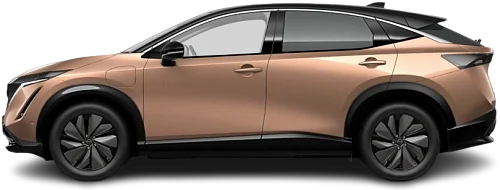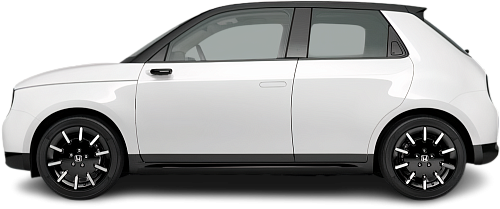USA EV Comparison: Nissan Ariya 63 kWh AWD vs Honda e Base
Struggling to Decide? Let AI Help!
Your AI Summary Is Ready!
General Info
The Nissan Ariya 63 kWh e-4ORCE AWD (2021-…) is currently produced, it has a starting price of $43590. The Honda e (2020-2022) has been discontinued, it was never offered for sale in the United States.
The Nissan Ariya 63 kWh e-4ORCE AWD (2021-…) is a SUV, whereas the Honda e (2020-2022) is a Hatchback.
| Property | Nissan Ariya 63 kWh AWD | Honda e Base |
|---|---|---|
| Years of Production | 2021-… | 2020-2022 |
| Current Status | Produced | Discontinued |
| Country of Manufacture | Japan, China | Japan |
| Body Style | SUV | Hatchback |
| Market Availability | USA | EU |
| Price USA (New) | $43590 | - Price USA (New) |
| Price USA (Used) | $18500 | - Price USA (Used) |
| GCC Score | 5.6 | 4.6 |
Range and Efficiency
While the Nissan Ariya 63 kWh e-4ORCE AWD (2021-…) offers a longer real-world range and a bigger battery, it is less energy-efficient than the Honda e (2020-2022).
| Property | Nissan Ariya 63 kWh AWD | Honda e Base |
|---|---|---|
| Range (EPA) | 205 mi | - Range (EPA) |
| Range (WLTP) | - Range (WLTP) | 138 mi |
| Range (GCC) | 195 mi | 117 mi |
| Battery Capacity (Nominal) | 66 kWh | 35.5 kWh |
| Battery Capacity (Usable) | 63 kWh | 28.5 kWh |
| Efficiency per 100 mi | 32.3 kWh/100 mi | 24.4 kWh/100 mi |
| Efficiency per kWh | 3.1 mi/kWh | 4.11 mi/kWh |
| Range and Efficiency Score | 5.1 | 5.8 |
Charging
Both vehicles utilize a standard 400-volt architecture.
The Nissan Ariya 63 kWh e-4ORCE AWD (2021-…) offers faster charging speeds at DC stations, reaching up to 130 kW, while the Honda e (2020-2022) maxes out at 46 kW.
The Nissan Ariya 63 kWh e-4ORCE AWD (2021-…) features a more powerful on-board charger, supporting a maximum AC charging power of 7.2 kW, whereas the Honda e (2020-2022) is limited to 6.6 kW.
| Property | Nissan Ariya 63 kWh AWD | Honda e Base |
|---|---|---|
| Max Charging Power (AC) | 7.2 kW | 6.6 kW |
| Max Charging Power (DC) | 130 kW | 46 kW |
| Architecture | 400 V | 400 V |
| Charge Port | CCS Type 1 | CCS Type 2 |
| Charging Score | 4.6 | 3.6 |
Performance
The Honda e (2020-2022) is rear-wheel drive, while the Nissan Ariya 63 kWh e-4ORCE AWD (2021-…) offers an all-wheel drive system.
The Nissan Ariya 63 kWh e-4ORCE AWD (2021-…) boasts greater motor power and accelerates faster from 0 to 60 mph.
| Property | Nissan Ariya 63 kWh AWD | Honda e Base |
|---|---|---|
| Drive Type | AWD | RWD |
| Motor Type | EESM (front), EESM (rear) | PMSM |
| Motor Power (kW) | 250 kW | 100 kW |
| Motor Power (hp) | 335 hp | 134 hp |
| Motor Torque | 413 lb-ft | 232 lb-ft |
| 0-60 mph | 5.1 s | 8.7 s |
| Top Speed | 124 mph | 90 mph |
| Performance Score | 5.2 | 2.8 |
Dimensions
The Nissan Ariya 63 kWh e-4ORCE AWD (2021-…) is longer, wider, and taller.
The Nissan Ariya 63 kWh e-4ORCE AWD (2021-…) boasts a more extended wheelbase.
| Property | Nissan Ariya 63 kWh AWD | Honda e Base |
|---|---|---|
| Length | 180.9 in | 153.3 in |
| Width (with Mirrors) | 85.5 in | - Width (with Mirrors) |
| Width (w/o Mirrors) | 72.8 in | 69 in |
| Height | 65.4 in | 59.5 in |
| Wheelbase | 109.3 in | 99.9 in |
Cargo and Towing
The Nissan Ariya 63 kWh e-4ORCE AWD (2021-…) provides more cargo capacity, featuring both a larger trunk and more space with the rear seats folded.
Neither car is equipped with a frunk (front trunk).
The Nissan Ariya 63 kWh e-4ORCE AWD (2021-…) has a towing capacity of up to 1500 lb, whereas the Honda e (2020-2022) is not officially rated for towing in the US.
| Property | Nissan Ariya 63 kWh AWD | Honda e Base |
|---|---|---|
| Number of Seats | 5 | 4 |
| Curb Weight | 4608 lb | 3501 lb |
| Cargo Volume (Trunk) | 22.8 ft3 | 6 ft3 |
| Cargo Volume (Max) | 59.7 ft3 | 30.4 ft3 |
| Cargo Volume (Frunk) | - Cargo Volume (Frunk) | - Cargo Volume (Frunk) |
| Towing Capacity | 1500 lb | - Towing Capacity |
| Cargo and Towing Score | 6.8 | 3.8 |




